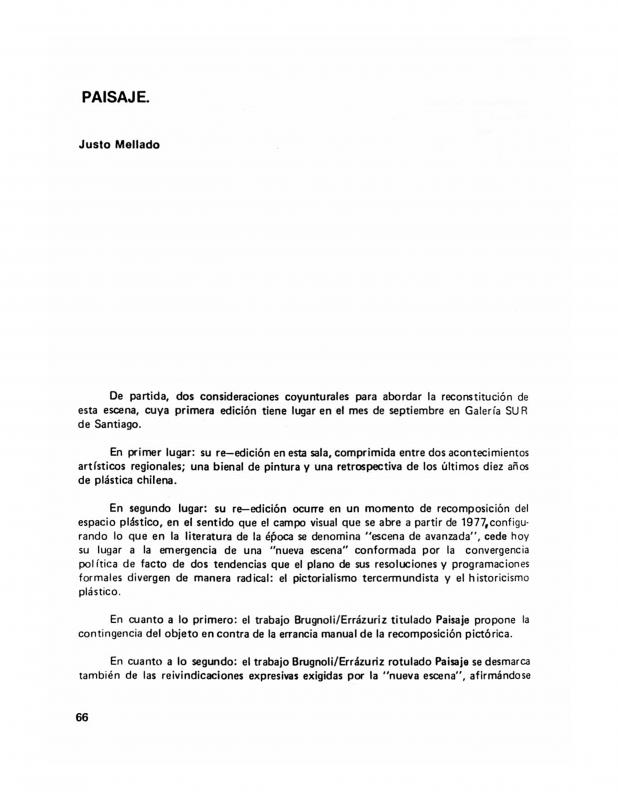Nelly Richard (b. 1948) wrote "Desde el andén" for a debate that took place during the Paisaje / Brugnoli / Errázuriz exhibition at the Galería Sur in Santiago, Chile, in September 1983. It was part of Cuadernos de/para el análisis 1 (1983), a self-published collection of texts by Richard and the critic Justo Pastor Mellado (b. 1949) that had appeared in magazines or had been written for roundtable discussions and seminars. The goal of the publication was, as they explain, to document the arguments presented during public debates on “the struggle for meaning,” a necessary emphasis after the decade-long Pinochet dictatorship that censored content and meaning. The collection is divided into four sections: (I) Vanguardia e instituciones (Vanguard and Institutions), (II) Referencialidad política en el campo de las artes visuales (Political Referenciality in the Visual Art Field), (III) Problemática de una cultura periférica (Peripheral Culture Issues), and (IV) Feminismo e identidad social (Feminism and Social Identity). Richard’s text is in Section III, which is, in turn, divided into “Moments,” in this case “Segundo momento: la función de ilustración” (Second Moment: The Function of Illustration). [Also on the subject of this exhibition, see Mellado’s text "Paisaje" (doc. no. 730016).]
Paisaje / Brugnoli / Errázuriz sought to question Chilean society through the language of installations made of debris and found objects. Francisco Brugnoli (b. 1935) and Virginia Errázuriz (b. 1941) had worked together on projects of this kind since the late 1960s. At the time, the installation was seen as an approach to Pop Art because the objects and debris were associated with consumer society. During the Pinochet dictatorship (1973–90) both artists played an important role in the visual art field. They fostered space for critical resistance to the authoritarian policies of the military government that injected its influence into higher education and, therefore, art instruction. The TAV (Taller de Artes Visuales) was one of their most ambitious and best-known initiatives, functioning as both a work space for artists and a discussion space for different actors in the field of the visual arts.
In response to this event, Richard asks why art has not changed much over the course of time regardless of social conditions (during the military dictatorship), and why the exhibition ignores the renewal (expressed in the visual arts) encouraged by the so-called Escena de Avanzada. The problem, in her opinion, is a lack of context; the works and their components are installed in the exhibition space at a considerable remove from any social milieu.

